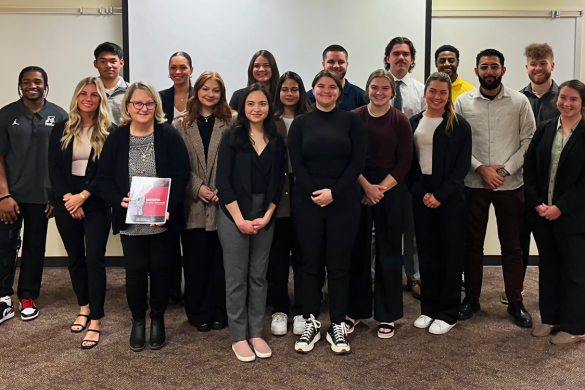Michael Homoya, botanist and plant ecologist for the Indiana Department of Natural Resources, lectured about the importance of nature preserves at noon on March 26 in Lilly Science Hall. Homoya has worked for the DNR for 32 years, before which he taught at various universities.
“I’ve had what I think is the best job one could possibly have: I get to see the wildest parts of Indiana,” he said. “And, yes, there are some quite wild areas in Indiana, contrary to what you might think.”

Botanist and plant ecologist Michael Homoya speaks to a Plant Biology class on the importantance of nature preserves on March 26.
Associate Professor of Biology Sandra Davis invited Homoya to speak to her Plant Biology class, but she opened up the event to the entire campus community. Davis said that she knew Homoya because they are both members of the Indiana Academy of Sciences.
“I’ve heard him talk there before, … and I always like to have somebody that does natural areas, natural populations,” Davis said. “… I try to get a variety of different kinds of talks.”
Homoya started the lecture by talking about Indiana’s past. According to him, 200 years ago the state consisted of 21 million acres of forest and two million acres of prairie. However, he said that as European settlers began to move in and clear the land, the number shrank to four million acres of forest and 1,000 acres of prairie.
“They cleared the trees and plowed it, and unfortunately they didn’t have a great concern about soil erosion,” he said. “To them, it looked like the resources were infinite, but they weren’t.”
According to Homoya, although the biodiversity in Indiana has shrunk, there are still many wild species of plants and animals in the state. Homoya said that Indiana has four different “micro-biomes,” areas with plants and animals unique to that type of habitat.
The micro-biomes that Homoya spoke about are on each side of Indiana. The eastern part of the state, towards Richmond, Ind., is forest with Green Salamanders and Timber Rattlesnakes. The western part of the state, along the Illinois border, is a prairie ecosystem, with the prairie white fringed orchid. The southern part of the state is lowlands with swamps that feature bald cypress trees and one of the northernmost populations of the mole salamander. The northern part of the state is wetlands with lakes.
Homoya said that the most important tool in protecting the state’s ecology is educating people, especially at a young age.
“If they know and see that those things are out there, then they come to—by learning about them or seeing them—come to appreciate them. That’s one of the biggest steps,” he said. “If they come to appreciate them, then they’ll want to protect them.”
Homoya said that the DNR controls 126 nature preserves throughout the state, and even more preserves are privately owned. Those interested in visiting or finding out more about the Indiana nature preserves can find a list at naturepreserves.dnr.in.gov.
“I’m not saying that we should never develop areas or utilize our landscapes,” he said. “We need to eat. We need to live in structures and all that. We [DNR] are not just face value, or as a general rule, against proper development.”
However, Homoya said, development cannot happen at the expense of the wildlife, plants and natural landscapes. Near the end of the lecture, Homoya quoted “Sand County Almanac” author Aldo Leopold, who wrote: “To keep every cog and wheel is the first precaution of intelligent tinkering.”






